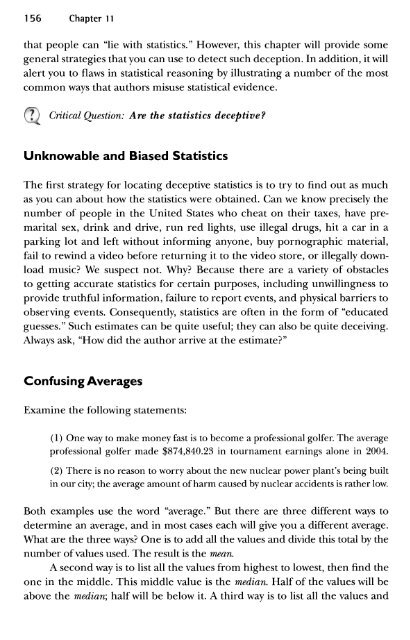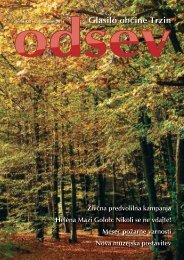Asking the Right Questions, A Guide to Critical Thinking, 8th Ed
Asking the Right Questions, A Guide to Critical Thinking, 8th Ed
Asking the Right Questions, A Guide to Critical Thinking, 8th Ed
You also want an ePaper? Increase the reach of your titles
YUMPU automatically turns print PDFs into web optimized ePapers that Google loves.
156 Chapter 11<br />
that people can "lie with statistics." However, this chapter will provide some<br />
general strategies that you can use <strong>to</strong> detect such deception. In addition, it will<br />
alert you <strong>to</strong> flaws in statistical reasoning by illustrating a number of <strong>the</strong> most<br />
common ways that authors misuse statistical evidence.<br />
(j) <strong>Critical</strong> Question: Are <strong>the</strong> statistics deceptive?<br />
Unknowable and Biased Statistics<br />
The first strategy for locating deceptive statistics is <strong>to</strong> try <strong>to</strong> find out as much<br />
as you can about how <strong>the</strong> statistics were obtained. Can we know precisely <strong>the</strong><br />
number of people in <strong>the</strong> United States who cheat on <strong>the</strong>ir taxes, have premarital<br />
sex, drink and drive, run red lights, use illegal drugs, hit a car in a<br />
parking lot and left without informing anyone, buy pornographic material,<br />
fail <strong>to</strong> rewind a video before returning it <strong>to</strong> <strong>the</strong> video s<strong>to</strong>re, or illegally download<br />
music? We suspect not. Why? Because <strong>the</strong>re are a variety of obstacles<br />
<strong>to</strong> getting accurate statistics for certain purposes, including unwillingness <strong>to</strong><br />
provide truthful information, failure <strong>to</strong> report events, and physical barriers <strong>to</strong><br />
observing events. Consequently, statistics are often in <strong>the</strong> form of "educated<br />
guesses." Such estimates can be quite useful; <strong>the</strong>y can also be quite deceiving.<br />
Always ask, "How did <strong>the</strong> author arrive at <strong>the</strong> estimate?"<br />
Confusing Averages<br />
Examine <strong>the</strong> following statements:<br />
(1) One way <strong>to</strong> make money fast is <strong>to</strong> become a professional golfer. The average<br />
professional golfer made $874,840.23 in <strong>to</strong>urnament earnings alone in 2004.<br />
(2) There is no reason <strong>to</strong> worry about <strong>the</strong> new nuclear power plant's being built<br />
in our city; <strong>the</strong> average amount of harm caused by nuclear accidents is ra<strong>the</strong>r low.<br />
Both examples use <strong>the</strong> word "average." But <strong>the</strong>re are three different ways <strong>to</strong><br />
determine an average, and in most cases each will give you a different average.<br />
What are <strong>the</strong> three ways? One is <strong>to</strong> add all <strong>the</strong> values and divide this <strong>to</strong>tal by <strong>the</strong><br />
number of values used. The result is <strong>the</strong> mean.<br />
A second way is <strong>to</strong> list all <strong>the</strong> values from highest <strong>to</strong> lowest, <strong>the</strong>n find <strong>the</strong><br />
one in <strong>the</strong> middle. This middle value is <strong>the</strong> median. Half of <strong>the</strong> values will be<br />
above <strong>the</strong> median; half will be below it. A third way is <strong>to</strong> list all <strong>the</strong> values and



